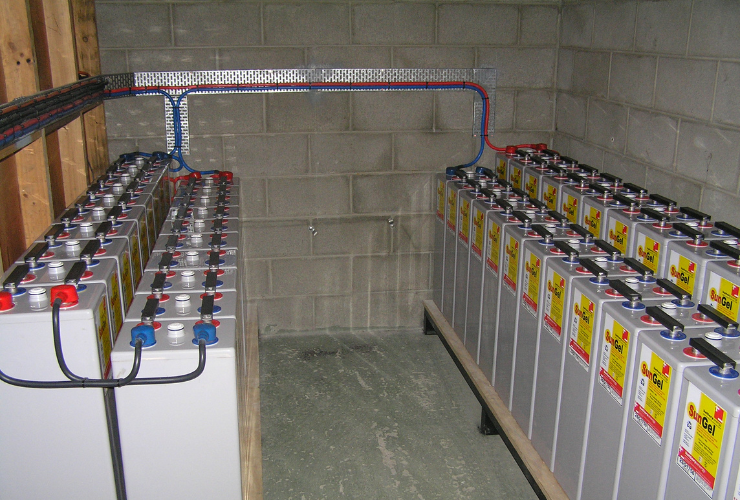Fast read
A deep cycle battery is a type of battery that is intended to be regularly discharged and recharged.
Deep cycle batteries can be discharged up to 80-100% of their capacity (for lithium-based batteries) or 50% of their capacity (for lead-acid batteries) (for lead-acid batteries). These batteries are not talked about much, but they are commonly used to power things like home appliances, smartphones, and laptops.
A standard car battery, on the other hand, is designed for short, sharp bursts of power to start an engine and is not intended to be discharged and recharged on a regular basis.
The key structural difference between deep cycle batteries and standard batteries is that deep cycle batteries have thicker separators and plates and denser electrolyte/ active material. They are not interchangeable and using them for the wrong purpose will damage the battery.
How Are Deep Cycle Batteries Different From Standard Batteries?
What is a Deep Cycle Battery?
A deep cycle battery is made to give consistent power to systems like solar panels that need daily charging and discharging. These batteries can use up to half or all of their power, providing a steady and long-lasting source of energy. The usable capacity of a deep cycle battery is the amount of charge you can use before needing to recharge it. This helps the battery last longer and work more efficiently.
In contrast, standard batteries, such as those used in cars, are designed to deliver short bursts of high power to start engines. These batteries typically use only about 5% of their capacity before needing to be recharged.
Deep cycle batteries are ideal for renewable energy systems. They can handle frequent deep discharges. They provide a reliable and sustainable power source.
Different Types
Deep cycle batteries come in different types, each with its own benefits and care needs. The most common types are flooded lead-acid batteries, lithium-ion batteries, and AGM (absorbent glass mat) batteries.
Flooded lead-acid batteries are cheap and reliable but need regular upkeep, like checking water levels and cleaning.
Lithium-ion batteries are popular because they last longer, are very efficient, and require little maintenance. They are also lightweight and can handle deep discharge cycles better than other types.
AGM batteries are strong and don’t need much care. They are spill-proof and can be installed in various ways, making them versatile.
Each type of battery has its own advantages, making them good for different uses.
Flooded Lead Acid Batteries
Flooded lead acid batteries are old batteries made by putting lead plates in a liquid called electrolyte. These batteries have a usable capacity of 25% to 50% and require regular maintenance to ensure optimal performance. The chemical reaction caused by the lead plates being submerged in an electrolyte leads to a decrease in the electrolyte level over time.
To keep the batteries working well, add distilled water regularly. Also, clean any acid buildup from the terminals and nearby areas.
Lithium-Ion Deep Cycle Batteries
Lithium-ion deep cycle batteries have quickly become the preferred option for many renewable energy systems, including solar systems. These batteries can last up to 5000 charge cycles, have a usable battery capacity of 80% to 100%, and feature a fast recharge rate. Lithium-ion batteries provide steady voltage during use, ensuring reliable performance for tasks such as lighting in homes.
Lithium-ion batteries do not need manual maintenance like flooded lead-acid batteries. However, they still benefit from regular battery care.
AGM Deep Cycle Batteries
AGM (Absorbent Glass Mat) deep cycle batteries use a mat placed between lead plates to absorb the electrolyte, preventing movement and leakage. The mat also acts as a damper, making the battery resistant to shocks, vibrations, and low temperatures.
AGM batteries charge quickly but are susceptible to overcharging, which can damage the battery. To avoid this, it is best to use a regulated charger. Like lithium-ion batteries, AGM batteries do not require manual maintenance but should still receive standard battery care.
Deep Cycle Batteries vs. Standard Batteries
The primary difference between deep cycle batteries and standard batteries lies in their design and intended use. Standard batteries, also known as starter or cranking batteries, deliver a short, sharp burst of power to start an engine and then stop supplying power while recharging. They typically use around 5% of their charge capacity at a time and are not intended for continuous use.
In contrast, deep cycle batteries have thicker separators and plates, denser electrolytes, and more active material. These features enable the batteries to provide a continuous power supply over a long period.
As a result, these batteries and standard batteries are not interchangeable. Using a standard battery for a continuous power supply would run out of charge quickly and cause damage. Using a deep cycle battery for high-current applications like starting motors could also cause damage.
Applications
These batteries are essential in various applications, particularly in renewable energy systems. Solar power systems store energy from the sun in batteries. This stored energy is used during the night or on cloudy days. This capability ensures a consistent power supply even when solar panels are not actively generating electricity.
Deep cycle batteries are also used in other applications such as marine environments, RVs, and off-grid power systems. Their ability to provide a steady power output over extended periods makes them ideal for these uses. Improvements in lithium-ion battery technology have made these batteries better and longer-lasting. This has increased the number of ways they can be used.
Conclusion
In summary, these batteries are a vital component in renewable energy systems and various other applications requiring a continuous power supply. Deep cycle batteries are different from standard batteries. They are made to be used regularly and discharge most of their power. Standard batteries are for starting engines.
There are various types of deep cycle batteries like flooded lead-acid, lithium-ion, and AGM batteries. They have different advantages and maintenance needs for different uses.
Understanding the distinctions between deep cycle batteries is important. Selecting the correct battery can enhance the performance of your energy storage system. It can also extend the battery life of the system.
By recognising the distinct features and benefits of deep cycle batteries. You can make informed decisions about their use in your renewable energy systems or other continuous power applications. This knowledge will help you optimise your energy storage solutions, ensuring reliable and efficient performance for years to come.

